Budget-friendly choices don’t have to compromise your protein intake; in fact, they can help you maintain a healthy lifestyle without breaking the bank. In this guide, you’ll discover a variety of high-protein foods that are not only affordable but also versatile and easy to incorporate into your meals. Whether you’re looking to build muscle, lose weight, or simply maintain your energy levels, this list will empower you to make smarter food choices while keeping your wallet happy.
Key Takeaways:
- Beans and Legumes: Versatile and rich in protein, these are highly economical sources of nutrition.
- Eggs: Packed with high-quality protein, they are an affordable staple for meals and snacks.
- Greek Yogurt: A protein-dense option that can be used in various dishes and eaten alone.
- Canned Tuna: A convenient and budget-friendly way to add protein to salads and sandwiches.
- Peanut Butter: Inexpensive and nutrient-rich, it makes for a fulfilling addition to snacks or meals.
- Chicken Thighs: Often cheaper than chicken breasts, they offer similar protein content at a lower price.
- Split Peas: An excellent source of protein that is affordable and easy to incorporate into soups or stews.

Types of Budget-Friendly High Protein Foods
A variety of budget-friendly high protein foods can help you meet your nutritional needs without breaking the bank. You’ll find options from both plant and animal sources, allowing you to choose what best fits your lifestyle. Consider incorporating the following choices into your diet:
| Plant-Based Options | Animal-Based Options |
|---|---|
| Legumes (beans, lentils) | Eggs |
| Peanut butter | Chicken thighs |
| Quinoa | Ground turkey |
| Tofu | Canned tuna |
| Chickpeas | Greek yogurt |
Knowing the types of protein-rich foods available will help you design a well-rounded meal plan that suits your budget and health goals.
Plant-Based Options
For those seeking plant-based protein sources, legumes and grains stand out as economical choices. Beans, lentils, and chickpeas are not only rich in protein but also packed with fiber and imperative nutrients. Incorporating quinoa and tofu can enhance your protein intake while keeping your grocery bill low.
Animal-Based Options
Little can compete with the protein quality and bioavailability found in animal-based sources. Foods such as eggs, chicken, and canned fish make excellent, cost-effective additions to your diet. They offer not just protein but also important vitamins and minerals.
Types of animal-based protein options allow for a versatile diet. Eggs are highly affordable and versatile, providing about 6 grams of protein each. Chicken thighs are often less expensive than breasts while still delivering substantial protein content. Moreover, ground turkey is another wallet-friendly alternative, offering lean protein that can be used in a variety of dishes. Lastly, canned fish like tuna or salmon presents an efficient solution, giving you both protein and healthy omega-3 fatty acids at an economical price.

Tips for Maximizing Protein on a Budget
Some effective tips to boost your protein intake without breaking the bank include:
- Buy in bulk to save money.
- Opt for less expensive protein sources like beans, lentils, and eggs.
- Utilize discount grocery stores or farmers’ markets for fresh options.
- Look for sales and use coupons whenever possible.
Recognizing the best strategies can help you achieve a satisfying high-protein diet. For more advice, check out this guide on How to Plan a High-Protein Diet on a Budget.
Smart Shopping Strategies
The key to smart shopping is planning ahead. Create a grocery list based on your weekly meal plan to avoid impulse purchases and stick to your budget. Visit local stores during sales, and consider buying frozen fruits and vegetables, which often cost less than fresh ones but offer similar nutritional benefits. You can also compare prices between stores to find the best deals.
Meal Prep and Planning
Maximizing your meal prep can help you save time and money while ensuring you meet your protein goals. Preparing meals in advance allows you to control portion sizes and use ingredients efficiently. Cook large batches of high-protein foods like chicken or quinoa and store them in the fridge for easy access throughout the week.
Budget-conscious meal prep can transform your eating habits. By dedicating a few hours each week to cooking and portioning out meals, you can ensure that you’re getting the nutrients you need while minimizing waste and expenses. Experiment with different recipes and prepare a variety of dishes so you won’t get bored with your meals, maximizing both your nutrition and savings.

Step-by-Step Guide to Incorporating High Protein Foods
Your journey to a high-protein diet starts with understanding how to seamlessly blend these foods into your meals. To maximize your grocery savings, check out Grocery Savings – The 5 Best Cheap Protein Sources. Below is a simple plan that can help:
| Step | Action |
|---|---|
| 1 | Identify your favorite high-protein foods. |
| 2 | Plan meals around these items. |
| 3 | Incorporate protein sources into each meal. |
| 4 | Experiment with recipes to keep meals interesting. |
Analyzing Your Daily Intake
There’s a simple way to assess your protein consumption. Start by tracking what you eat over a few days to identify how much protein each meal provides. Use a nutrition app or a food diary to highlight your protein sources, aiming to reach your daily goals and adjust quantities as needed.
Creating Balanced Meals
Even if you focus on incorporating more protein, it’s vital to create balanced meals that provide overall nutrition. Aim to include carbohydrates, healthy fats, and plenty of vegetables in your diet, all while ensuring that each meal has a good protein source. This balance can prevent energy dips and keep you feeling satisfied.
Meals that incorporate a variety of food groups will not only help you meet your protein needs but also provide vital vitamins and minerals. For example, pair grilled chicken with quinoa and a side of steamed broccoli for a complete dish. Similarly, beans on whole-grain toast topped with avocado can make a protein-rich breakfast. Tailoring your meals this way allows you to enjoy delicious varieties while maintaining your nutritional goals.
Factors to Consider When Choosing Protein Sources
Keep in mind that selecting the right protein sources involves several important factors:
- Source of protein (animal vs. plant-based)
- Nutritional content (vitamins, minerals, and other nutrients)
- Cost and availability
- Preparation time and convenience
- Your dietary preferences and restrictions
This holistic approach ensures you meet your protein needs in a balanced manner.
Nutritional Content
Any protein source you consider should deliver not just protein but also crucial vitamins and minerals. Think about the overall nutritional profile, including how each option can contribute to your daily dietary needs. Opt for foods that provide additional health benefits beyond protein, which can support your overall well-being.
Cost-Effectiveness
On a budget, evaluate the cost-effectiveness of different protein sources. This involves analyzing the price per serving or per gram of protein to determine which options offer the best value for your money.
To maximize your spending, compare various brands and local prices for protein sources like beans, lentils, and canned fish. Bulk buying can also reduce costs, as can preparing meals at home using simple ingredients. By prioritizing cost-effective proteins, you can sustain a high-protein diet without overspending, making it accessible and affordable for your financial situation.

Pros and Cons of High Protein Diets
Many people are drawn to high protein diets for their various benefits, but it’s important to weigh the pros and cons before making a commitment. Understanding both sides can help you tailor your dietary choices to best suit your lifestyle and health goals.
Pros and Cons of High Protein Diets
| Pros | Cons |
|---|---|
| Supports muscle growth | Can be expensive |
| Aids in weight management | May cause digestive issues |
| Increases satiety | Potential nutrient imbalances |
| Enhances metabolism | Not suitable for all diets |
| Improves recovery post-exercise | Can contribute to kidney strain |
Health Benefits
An emphasis on high protein consumption can lead to several health benefits, such as improved muscle development, enhanced weight management, and increased feelings of fullness. This nutrient also plays an important role in the recovery phase post-workout, supporting your overall fitness journey efficiently and effectively.
Potential Drawbacks
Potential drawbacks of a high protein diet may include possible digestive discomfort and the risk of nutrient imbalances. It’s important to consider these aspects in order to ensure a sustainable and healthy eating pattern.
Health risks associated with high protein intake can vary depending on individual health conditions and dietary preferences. For those with pre-existing kidney issues, a protein-heavy diet may exacerbate problems. Moreover, if you’re consuming excessive amounts of red or processed meats, this can lead to other health concerns. It’s advisable to balance your protein sources and consult with a healthcare professional to tailor an approach that fits your specific health needs.
Frequently Asked Questions about Budget-Friendly Proteins
Despite navigating the world of protein-rich foods on a budget, you may have several questions about the best options available to you. Understanding what makes a protein source both affordable and nutritious can help you make informed choices. Consider factors such as portion sizes, nutritional value, and versatility in recipes. You’ll find that legumes, canned fish, and eggs are some of the top contenders for high protein at low cost. Addressing your concerns about meal planning and sourcing can ultimately enhance your diet and save you money without compromising on your protein intake.
Final Words
Following this guide, you can confidently choose budget-friendly high protein foods that support your health and fitness goals without straining your wallet. By incorporating versatile options like legumes, eggs, and Greek yogurt into your meal plans, you can enhance your nutrition while enjoying delicious meals. With smart shopping and mindful cooking, you can maintain a high-protein diet that suits your lifestyle and budget. Empower yourself with these choices, and watch your energy and overall well-being thrive.
FAQ
Q: What are some budget-friendly high protein food options?
A: There are several affordable high protein foods you can include in your diet. Some excellent options are eggs, canned tuna, lentils, chickpeas, black beans, Greek yogurt, and cottage cheese. These foods not only provide a good protein source but are also versatile and can be used in various recipes.
Q: How can I include more protein in my meals without spending a lot?
A: To incorporate more protein without breaking the bank, consider meal prepping with cheaper protein sources. For example, you can make lentil soup, chickpea salad, or stir-fried tofu with vegetables. Additionally, look for sales on meat or consider buying in bulk and freezing portion sizes for later use. Using beans and legumes as meat substitutes in recipes can also help boost protein levels while cutting costs.
Q: Are plant-based proteins as effective as animal proteins?
A: Plant-based proteins, while sometimes lower in certain amino acids compared to animal proteins, can still be very effective. Combining different plant proteins like beans and rice can create a complete amino acid profile. Foods such as quinoa, soy products, and legumes can offer substantial protein advantages while being cost-effective.
Q: What are some high protein snacks that are affordable?
A: Affordable high protein snacks include items like hard-boiled eggs, Greek yogurt, nut butter with whole grain crackers, and roasted chickpeas. You can also make your own protein bars using oats, nut butter, and protein powder. These options are not only budget-friendly but also portable for busy lifestyles.
Q: How can I ensure I’m getting enough protein while on a budget?
A: To ensure adequate protein intake on a budget, focus on planning your meals around protein-rich foods. Look for sales or discounts on high protein items, and consider shopping at local markets or bulk stores. Incorporating a mix of both animal and plant-based protein sources can help you reach your daily protein goals while keeping costs manageable.
Q: What are some easy recipes featuring budget-friendly high protein foods?
A: Some easy recipes include lentil stew, chickpea curry, scrambled eggs with veggies, and Greek yogurt parfaits with fruit and nuts. You can also prepare a black bean salad or a quinoa and vegetable stir-fry. These recipes are nutritious, simple to make, and cost-effective.
Q: Is it necessary to buy expensive supplements to meet protein needs?
A: No, it is not necessary to purchase expensive supplements to meet your protein needs. Many affordable whole food sources provide sufficient protein for most individuals. Focus on incorporating a variety of high protein foods into your meals and snacks instead of relying on supplements for protein intake. Whole foods are generally safer and offer additional nutrients that supplements may lack.





